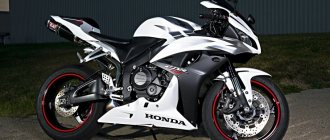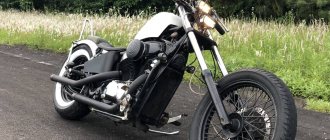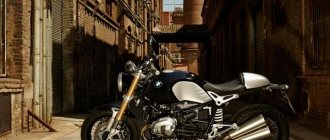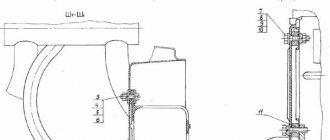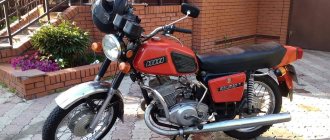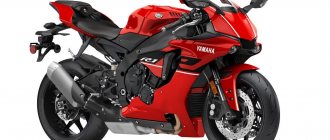For whom
Here are the main features of the machine:
- Four-speed gearbox;
- some minimalism in design and similarity to Steed 400;
- 44 Nm and 36 hp.
The motorcycle is not suitable for people who have just begun to master such motorcycles. The bike will be just right for those who have already ridden a lot on the Steed 400 and want to switch to a bike with the same design and dimensions. The Honda Steed 600 is so similar to its predecessor that, without looking closely at the details, they can easily be confused.
So my second season on Steed has come to an end. I have already described my first impressions of this motorcycle here, and now I would like to tell you more detailed information. One thing I will say for sure - riding this motorcycle continues to evoke an inexplicable, irrational feeling of delight, independent of numbers, horses, acceleration and other characteristics. Carburetors
Over these two seasons, Shame blew my mind a little. Well, a little bit. Sometimes I wanted to pour gasoline on it and set it on fire)) The carburetors brought the most emotions. Oh, this mysterious miracle of the Japanese motorbike! No not like this. Oh, this mysterious miracle of the armless collective farm! Well, at least I don’t know what else such problems could be associated with.
In general, the carbs were enriched. Moreover, in traffic jams at near idle they even filled it up. The motorcycle began to run unevenly, the speed fluctuated. He farted and sneezed, tried to stall, and when releasing the gas and braking the engine, he fired a deafening forward flow. After replacing the membranes and needles it got a little better, but still not the same. The candles were black, the appetite was like that of a Horse, well, at least it stopped pouring. Verdict - collective farm or the wells of the dosing needles are worn out (and in these keikhins the wells are pressed in and are not intended for replacement). A moto with a direct flow, just a real true Thunderheader, who knows what the butts were hit there. Everyone tried to tune these carbs. And masters at different motorcycle service stations, and my husband and I did it ourselves. I re-read all 109 pages of the topic about carburetors on the stidoforum, I already know what levels to set in the float chamber, how and where to blow, what to turn, how to adjust the mixture quality using the tachometer, and in general I can give lectures on these topics))) At least a couple of times per Steed was dismantling the season for another attempt to set up a normal mixture. But now you can set a record for the fastest disassembly and assembly of Steed))))
No, he was driving. In principle, it worked normally and never failed. But the realization that something was wrong with the technology was simply infuriating. As a result, in the middle of the second season, another carbs were purchased. And all the problems with the mixture were solved in one fell swoop! (True, during the first launch and setup on new carbs, just in case, I put an angle grinder in front of Steed so that he could see). The spark plugs are beautiful, the consumption is 4 on the highway, the engine runs smoothly, there are no failures, it produces its maximum speed - there’s simply nothing to complain about. The horse is dead - get off, as they say. If a spare part is worn out, you don’t have to suffer and spend half a season endlessly trying to adjust something. You just need another, working spare part, and everything will be fine!
Shame Shame
The second problem, which was mind-blowing a little at a time, was the age of the rubber bands. The first thing that was discovered was moisture near the brake machine. It was already slurping. We went to look - and there the boot had dried out, several kilograms of dirt (possibly even Japanese) had accumulated under it, causing the GTZ piston to partially rust, and the cuffs began to leak brake fluid. They removed the car, took it home, washed it, went through it, replaced the worn parts with new ones from the repair kit, and put everything back together. Life hack - it is best to pump the front brake from the bottom up, using a syringe. It is easier to push air bubbles up than to push them down.
The second wet moment was associated with the dried rubber of the radiator cap, which also acts as a valve to the expansion tank. After driving along the highway, leaks were discovered on the top of the radiator. Using the search method, we found a plug in which the rubber seal was all cracked and was leaking when the pressure in the system increased. The cork was picked up from some car without any problems.
Well, the third important point is the drive sprocket shaft seal. At first they thought that the oil pressure sensor was sweating because it leaked under the cap (protective boot). But it turned out that it was the oil seal, it was flowing from top to bottom, and even the oil filter was completely clogged, which made people think that it was it. After replacing the drive sprocket seal (and at the same time the gearbox shaft seal, let it be, old age does not benefit the rubber bands) Steed stopped pissing. Now I know that for the next ten years there will definitely be no sweat in these nodes!
Service
There were no more breakdowns or troubles. If there was more finance, it would be ideal to change everything at once. All seals, boots, hoses, cables, etc. But since this is too expensive for our budgets, everything was done gradually.
In general, what follows is banal. The oil and antifreeze, front and rear pads, cables, brake fluid, chain and sprockets, clutch, fork seals and boots were changed. Hmm, that seems to be all for now.
Improvements
I got the motorcycle already with bars and a luggage system. Which is very cool, because it’s all made well, from stainless steel, and to do it just as beautifully and well would be very financially stressful.
What we have already done:
— Rear trunk. There is no arguing about tastes, I don’t need to talk about the bread box here, please)) The main thing is that I like it. And the useful volume, where you can load a bunch of everything you need, from a passenger helmet to a couple of shopping bags for a week, completely negates all possible shortcomings. And also this constant from people without trunks: “And put my Coke in,” “Can I hide my jacket for you?” and so on. speaks for itself)))
— Remaking the rear shock absorber. This is simply a great thing! Over the years of driving on our roads, the spring sagged and began to break through. I found many different options on the Internet, from trying to insert a shock absorber from some other motorcycle (usually this immediately lifts the motorcycle’s ass up and looks very bad), to ordering another used shock absorber from Steed (with an unknown result, what if it’s like this sagging), or buying all sorts of YSS for crazy money, which seem to fit, but are unreasonably expensive. So, the problem can be solved simply and inexpensively - the original spring is replaced with a spring from the cabin of a Hyundai truck. The result is that in hardness modes 2 or 3 it does not penetrate even with a total weight of the pilot and passenger of 160 kg. At the same time, at the same setting and under me alone, it’s quite soft, it doesn’t hit the spine. The perfect solution!
— I had to change the steering wheel. Well, as it happened - in principle, I went through the first season normally and with a “stick”, but still it was not particularly convenient. I’m not tall enough, I had to reach for the steering wheel, it was a bit hard to steer. Therefore, we found and installed a stock “Y”, which just fit perfectly into my hands. With it, people with short stature are much more comfortable - the back is straight, the seat is vertical, the arms are relaxed. Like in a chair!
- Headlight. The stock light in Steed is so-so, especially when more than half of the oncoming traffic comes with collective farm xenon. Therefore, a Chinese copy of Daymaker was installed, which even has some kind of certification and a cut-off line. Driving in the dark has become much more comfortable (but I still don’t like it).
- Windshield. Adds to the look of the motorcycle and really protects it from the wind. In the rain you remain practically dry. Homemade wind deflector, made of plexiglass.
— Windproof guards on the steering wheel. They really protect your fingers from the wind. Even in cool weather you can ride with summer gloves. Well they look cute 
- All sorts of little things. Voltmeter type, extra. lights on the arches and lights on the tank.
Summing up
After the completely problem-free new Yubra, the old 25-year-old motorcycle periodically pissed me off. Change this, change that, adjust this, repair this. Moreover, according to the law of meanness, often right in the season. And, it would seem, all this is trifles. Rubber bands, seals. In general, pf, not worth attention. The compression is excellent, the hone is perfect, the wiring works, there are no complaints about the motor. But damn. It still infuriated me. And then I sat back in the saddle, rode aimlessly, listened to the bubbling of the forward flow, saw a lame instrument in front of me, and a small teardrop-shaped tank under me, felt the weight of this cow (surprisingly, the same 400s Shadovki and Draghi seem many times more light, probably because of the trail), and again, again I got a thrill, realized how much I love this Motorcycle! I don't need speed indicators, number of horses, torque, and all that stuff. Choppers, cruisers, that's not what they're talking about. Love for them is incomprehensible and inexplicable. You can drive 40 in the city in traffic and not even have any desire to overtake. Or drag along the highway at 80, if you’re not in a hurry - and don’t want to accelerate further. Such a strange expression appears on your face, a mixture of a “brick face” and a slight smile, when you get a thrill simply from the very fact of riding your favorite Horse. And when you leave it in the parking lot, be sure to look back to admire it.
Engine
The bike has a four-stroke two-cylinder V-shaped engine. Its effective volume is 583 cm³. Torque at its peak at 3000 rpm is 44 Nm, while at 6500 rpm the maximum power is 36 hp. The unit is cooled using liquid, and the fuel supply system here is carburetor.
Flaws
Over time, 400cc becomes not enough, so experienced pilots should immediately take a closer look at the STEED 600.
Even the developers noted the disadvantages of the model. True, they named only one - short suspension travel , which is completely unacceptable on a cruiser. When asked to correct this, they said that all improvements would be included in the new model.
Users added to the list of minuses. According to them, the motorcycle has:
- weak front brake;
- sometimes there is not enough engine power.
Some owners noted that even though this is a cruiser, you can’t travel long distances on it - the landing is uncomfortable.
and dignity
One of the main advantages of the “400” is the large selection of available tuning tools.
There were many more advantages noted:
- low center of gravity;
- reliability;
- availability of spare parts for repairs and tuning;
- controllability and maneuverability.
It is separately noted that despite its age, the bike still looks beautiful and modern.
Dimensions and weight
The wheelbase here is 1600 mm, and the seat height is 680 mm. Steed 600 is 2310 mm long, 1130 mm high, and 760 mm wide. The weight of the model with fuel reaches 217 kg, and without it – 204 kg. Tank volume – 11 l. 2.62 liters are consumed per 100 km of road.
Brief history of the model
1988 - start of production and sales of the Honda Steed 600. Model: Honda Steed 600 VLX (Japan). Frame number: PC21-100XXXX~. Factory designation: NV600Cj.
1989 - no significant changes. Model: Honda Steed 600 VLX (Japan). Frame number: PC21-105XXXX~. Factory designation: NV600Ck.
1990 - a passenger backrest is standard equipment on the motorcycle. Model: Honda Steed 600 VLX (Japan). Frame number: PC21-110XXXX~. Factory designation: NV600Cl.
1991 - model not produced. 1992 - no significant changes. Model: Honda Steed 600 VLX (Japan). Frame number: PC21-115XXXX~. Factory designation: NV600Cn.
1993 - fuel tank capacity increases from 9 to 11 liters. Model: Honda Steed 600 VLX (Japan). Frame number: PC21-120XXXX~. Factory designation: NV600Cp.
1994 - no significant changes. Model: Honda Steed 600 VLX (Japan). Frame number: PC21-130XXXX~. Factory designation: NV600Cr.
1995 is the last year of production. This year's models feature a 3D Steed emblem on the fuel tank. Model: Honda Steed 600 VLX (Japan). Frame number: PC21-140XXXX~. Factory designation: NV600Ct.
Chassis and brakes
The bike is equipped with a tubular steel frame. She perfectly conveys his calm but strong character. The frame shapes are quite strict, even classic, but elegant. The body is very similar to that of the 400th model. Like its predecessor, the steering wheel is of medium size, and the wheels are spoked.
The pendulum suspension at the rear is equipped with a monoshock absorber, and at the front a telescopic fork acts as a suspension. A drum acts as the rear brake, while a dual-piston caliper and 296mm disc brake up front.
Honda Steed 400 suspension specifications
We deliberately separated this part of the review into a separate chapter, because the suspension of this device really deserves attention and a separate discussion. Again, she is “unkillable”. Front wheel travel is provided by a standard telescopic fork (for a regular Steed) or a multi-link fork (for a Steed with the vlx index).
The rear suspension is equipped with softail shock absorbers. This choice was made due to reliability and the resulting illusion of the absence of a rear fork. This equipment is enough to carry two people in addition to its own 200 kg. curb weight. Yes, the motorcycle is not light, but that’s how a chopper should be. The weight ensures stability on the road while driving.
Regarding riding two people on the Honda Steed 400, reviews indicate that with a height exceeding 180 cm, the motorcycle becomes cramped. This is where the small overall dimensions come into play. Let us remember that this model was produced for the Japanese market. Driving independently is truly a pleasure, and its small dimensions provide the necessary maneuverability in urban conditions.
Video
This video gives us the opportunity to see how this “iron horse” behaves (this is the nickname the model received on the American market) not only on the track, but also while driving off-road.
It is noticeable that at speeds of up to hundreds of kilometers per hour, the motorcycle behaves amazingly; it seems that the driver does not feel any tension while driving.
Did you like the article? Tell your friends!
Comments (2)
- Arthur:
02/27/2015 at 17:25I think this model of motorcycle does not need unnecessary advertising. I dream of buying one for myself, my friends have already bought it and are enjoying riding it, they say it’s a pleasure. Well, thanks to this resource, I learned a lot of new and interesting things about this model, for which a special thank you.
Answer
- Yuri:
09/08/2016 at 16:52
The tank is not 8 but 9 liters, although this may have been the case on the 600 Steed. I had several of them in succession. and as you said, 11 liters is still not enough? I drove more than 300 km on a 600, and even more so on a 400, the steering generally eats very little. And regarding the VSE version, not only the rear wheel is different. rear fender, steering wheel, seat. panel. Thanks to the steering wheel, it looks much better than other versions.
Answer

